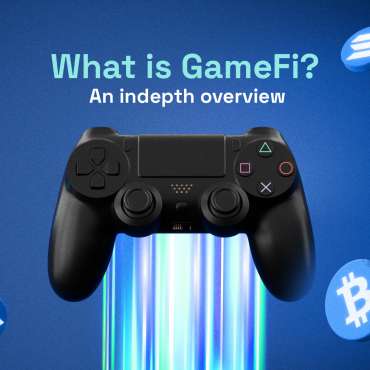As the gaming industry advances, Web3 is changing the way gamers interact with games. It brings decentralized ownership, new economic structures, and play-to-earn (P2E) options to improve gaming experiences while also increasing user retention. According to the research, the blockchain gaming market was valued at $4.83 billion in 2022 and is expected to grow at a compound annual growth rate (CAGR) of 68.3% from 2023 to 2030. It’s clear that web3 gamers love playing web3 games and from a player’s perspective, web3 games provide players with true ownership of digital assets – digital property rights – unlocking the freedom to buy, trade, and sell those assets.
This blog explores how Web3 gaming is transforming player retention via critical insights, statistics, and advantages, focusing on the shift from traditional Web2 gaming to Web3.
The Transition from Web 2 to Web 3 Gaming
Web2 gaming has dominated the scene for the past decade, thanks to centralized servers, in-game sales, and downloadable content. While these approaches have generated enormous earnings for game creators, they have given players little control over their virtual possessions and little physical ownership.
Web3 gaming, which uses blockchain technology, enables genuine digital asset ownership, transparency, and community-driven governance, resulting in a whole new user experience.
Web 2.0: Market Growth Stats
The rise of Web 2.0 has had a huge impact on the global data center industry. The market was valued at USD 2.04 billion in 2021, and it is predicted to increase even more by 2029, reaching USD 2.40 billion. This expansion is driven by the increased need for dynamic and interactive web applications and services, which constitute Web 2.0. As more enterprises and individuals rely on web-based platforms for communication, collaboration, and data storage, the need for dependable and scalable data centers grows. This trend is projected to continue, with a steady CAGR of 2.05% from 2022 to 2029.
Web 3.0: Market Growth Stats
Web 3.0 is seeing tremendous growth, with the global market expanding quickly. It reached USD 2.2 billion in 2022, but future projections are even more promising. By 2032, the Web 3.0 business is expected to be worth USD 81.9 billion, reflecting an astounding compound annual growth rate (CAGR) of 44.5%. This exponential increase demonstrates the revolutionary power of Web 3.0 technologies, which promise to redefine how we interact with the internet, handle data, and do business over the next decade.
Key Drivers of Player Retention in Web3 Gaming
True Ownership of Digital Assets
One of the most significant issues for players in traditional Web2 gaming is a lack of control over in-game assets. Most items, like skins, weapons, or characters, are exclusive to the game environment and cannot be bought or sold elsewhere. Web3 gaming addresses this by allowing actual ownership of in-game assets via non-fungible tokens (NFTs) on the blockchain. Web3 games reigned supreme, accounting for 34% of dapp activities and attracting 1.1 million active users every day.
This transition has changed the gaming experience by granting players ownership over their things, which they may trade, sell, or transfer across games or platforms. This additional layer of ownership increases player investment in the game, making them more likely to continue playing and contributing to the game’s economy.
Play-to-Earn models
Web3 gaming offers the notion of play-to-earn, which allows users to earn real-world money for their in-game activity. Players can earn real-money cryptocurrencies or NFTs by performing chores, participating in fights, or trading inside a game’s economy. This provides an extra incentive for users to stay involved since they may immediately gain monetarily from their time spent playing the game.
According to a Blockchain Gaming Alliance survey, 79.7% of gamers believe that they will retain in Web3 games because they were attracted by the earnings possibilities offered by P2E models. These gamers not only stay involved longer, but they also attract new participants into the ecosystem, increasing retention.
Interoperability Across Games
One of the most innovative parts of Web3 gaming is the possibility of interoperability, which allows in-game assets (such as characters, skins, or weaponry) to be shared across numerous games. This approach enables players to transport their asset investments from one game to another, resulting in a more fluid gaming experience. Players who know they can transfer their progress and assets between games are more inclined to stay in the Web3 ecosystem.
Decentralized governance and player involvement
Web3 games frequently include decentralized governance models, which give players a role in the game’s evolution via decentralized autonomous organizations (DAOs). Players who believe they have a say in defining the future of their favorite games are more likely to stay loyal and invested.
By allowing players to vote on updates, new features, and rule changes, Web3 games foster a sense of community ownership and belonging. This link to the growth process is a critical aspect of keeping gamers interested.
Benefits of Web3 Gaming for Retention
Increased Player Engagement
Web3 gaming ecosystems are intended to engage players more than traditional games by providing new incentives such as token rewards, asset trading, and game-based economies. These aspects form a continuous cycle of engagement in which users not only play the game but also actively participate in a thriving digital economy. As a result, Web3 games frequently have greater levels of daily active users (DAUs) than their Web2 equivalents.
According to a recent Coingecko analysis, 29 of the world’s 40 largest gaming companies are focusing on web3, with 7 studios actively developing web3 games in-house and others making direct investments in web3 gaming projects, and blockchain game development.
Stronger Community Bonds
Community-driven components of Web3 gaming, such as DAOs and NFT-based ecosystems, foster a greater sense of belonging and purpose among players. Web3 players are more than just customers; they are invested in the game’s success. This degree of commitment encourages a more devoted player base since players are emotionally and financially involved in the game’s success.
More Personalized and Rewarding Player Experiences
Web3 gaming allows gamers to tailor their gaming experience. NFTs allow players to modify their in-game characters and assets, and these changes may even be profitable. This unique degree of customization provides a more satisfying and engaging experience, keeping gamers coming back for more.
Furthermore, blockchain-based economies enable direct peer-to-peer trade of in-game assets, making the entire gaming experience more player-centric.
Closing Thoughts
Web3 gaming has led to a paradigm change in how players engage with games by providing actual asset ownership, new revenue models, and community-based governance. With increased interoperability, decentralized economics, and a strong feeling of community, Web3 gaming offers better experiences that promote player retention considerably beyond what standard Web2 games do.
As blockchain technology advances, the boundary between games and the digital economy becomes increasingly blurred, making player retention a critical statistic of success in this new era of gaming. To thrive in the Web3 gaming revolution, developers must embrace these new paradigms and provide seamless player experiences.




